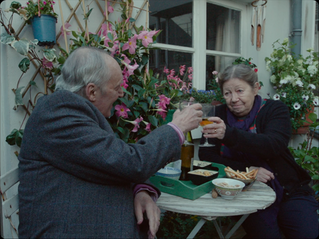Waltz with Bashir
- Jonny Rogers
- Jan 12, 2022
- 3 min read
Ari Folman, 2008

I first approached Waltz with Bashir from a place of aesthetic curiosity: while countless films claim to draw inspiration from comic books, how often does this inspiration factor into the production of the image itself? How many films could actually be mistaken for a graphic novel?
Waltz with Bashir is, assuredly, one of a kind; a film that proudly boasts such an idiosyncratic style, yet which does not justify itself solely on its aesthetic distinction. Focusing on the director’s inability to remember his experience as a soldier during the 1982 Lebanon War, the film is at once brutally real and deeply surreal, interweaving testimonies with accounts of visions, dreams and psychological experiments, the soundtrack oscillating between classical compositions and contemporary pop music.
Folman believes that the truth of his forgotten history lies dormant in a dream: a piercing image of bathing in the ocean as flares light up the streets of Beirut. Unsure whether this scene is the sole remnant of his repressed memories or a semiotically-rich allegory birthed in his subconscious, Waltz with Bashir shows Folman visiting numerous friends, journalists and therapists in search of clarity.
Despite the lasting controversy of the Israeli-Palestine conflict, the film doesn’t dwell too much on its historical context. At numerous points throughout, soldiers (some of whom, we are reminded, are still teenagers) are handed guns and told to shoot anything that comes into view. Solemn reflections are interrupted with montages of explosions set to rock music, as if the film’s shifting tone can never quite align itself with the abhorrence it depicts. The title itself derives from an interviewee’s account of dancing on the road to avoid heavy gunfire beneath posters of Bashir Gemayel, the militia commander-turned short term President of Lebanon. The film’s viewers, like the Israeli soldiers, are dropped into a story too complicated, obscure and surreal for anyone to ever fully understand, yet even justify.
Since my first viewing a number of years ago, the film has stuck with me as a memorable, if confusing, project. Having since started working for a charity focusing on human rights violations, however, it has gained a new meaning - or, rather, its meaning has become far richer. While I can’t claim to ever have stepped foot in a warzone, I have glimpsed the numbing impact of daily exposure to the violent horror of global conflict; the emotional inoculation that comes with regularly interacting with first-hand accounts of torture, mass starvation and state-sanctioned violence.
Reality unfiltered is, simply, indigestible; as Waltz with Bashir testifies, our fragile minds call for metamorphosis, transforming our private histories to negotiate the experiences we can neither apprehend nor rationalise. We are told of one soldier who is only able to process his trauma by describing it as a war film; of another plagued by dreams of the dogs he was commanded to execute. Even the film’s animation serves as a kind of buffer between the known and unknown, mediating between contemporary testimonies and undocumented history.
Towards the end of the film, Folman discovers that his vision is actually a fabrication; that he was, in fact, present when troops were lighting flares to illuminate the Shatila refugee camp for the Phalange militia to massacre. His residual guilt has mutated his memories to disassociate his participation in something unspeakably horrific. In its final moments, Waltz with Bashir abandons animation entirely, as if simulating the whiplash of revealing what has long been repressed: live news footage shows women weeping as they traverse the graves of their friends and family.
Waltz with Bashir is not a simple apology. Folman attempts neither to justify the actions of his nation nor his own; he is not sure that an explanation is even possible. Instead, he chooses to lay bare his guilty conscience for those willing to listen, seeking to unravel the filters that transform and dilute the dreadful pandemonium of history.








Comments